Dropping down to the picnic area, we discovered another group of hippos chilling out in the lake, sensible chaps really since the midday heat was making its presence felt. Bright blue dragonflies darted about along the water's edge. Whilst enjoying our picnic lunch in the 4x4, we smiled in amusement as large Black Kites swooped down to steal sandwiches out of the hands of those foolhardy enough to try and eat outside in the open. We had our doors open, and small, bright yellow Speke's Weaver Birds would land on them and edge their way towards the vehicle, shrilly chirping, "Spare a crumb, spare a crumb, matey." Their distinctive nests hung below the branches of a nearby tree.
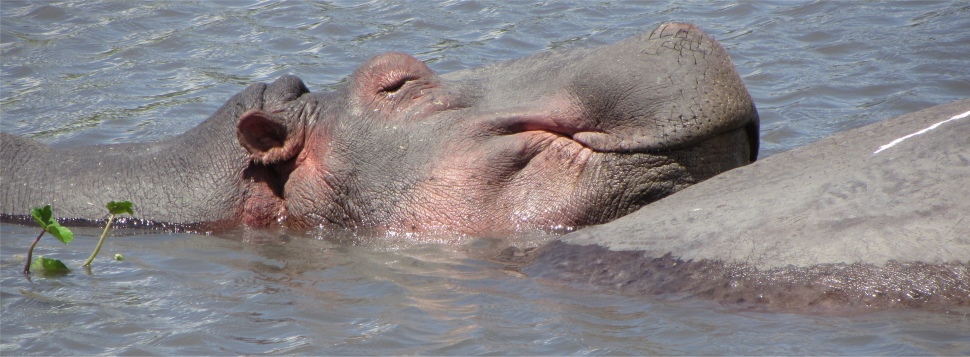
Hippo Chilling Out
|
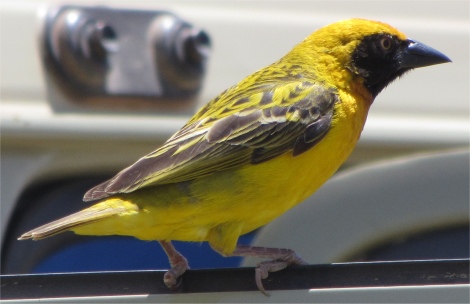
Speke's Weaver Bird
|
Dan chirped brightly to Kepha and Erasto in Swahili. He had a phrase book and was keen to practice on the two locals. His phrase book was mind-boggling. Some of the phrases it contained can at best be described as broadminded and leaving nothing to the imagination. It had Kepha in fits of laughter.
Sadly the time had come to leave this paradise, we had a very long haul to undertake back to Moshi. On our way back across the crater floor, we spotted a group of Lakeside Egrets and Blacksmith Plovers sharing real estate with each other. I was impressed with the extent of wildlife to be found in the crater.
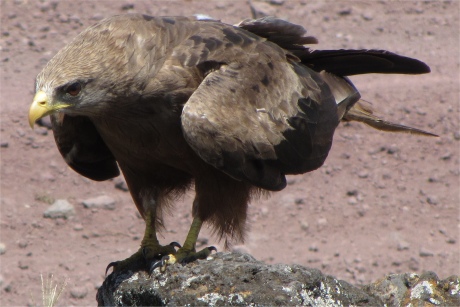
Black Kite
|
We laboriously climbed back up to the rim via a different route, passing through lush bush, made ever greener by a band of rain on the higher slopes. Where the rain had fallen, there was a heady aroma of the freshness mixed with the aromatic scent of herbs.
The road leading off from the rim seemed to take an eternity to traverse, the twisting, dusty, roller-coaster of a track had a surface resembling a battlefield. At last we reached the Ngorongoro Conservation Area entrance, we stopped to use the facilities. A small troop of baboons had stopped by too, the older ones engaged in mutual grooming, the baby trying to escape but gently pulled back by mam. A juvenile member of the troop was emptying the remaining contents of a can of Kilimanjaro beer down his throat. He staggered about for a while, or perhaps that was his normal swagger.
A large bus that had parked up had momentarily left a door open. Quick as a flash, a monkey dashed in, grabbed something or other, and was out and up a tree with his pal examining the find before the bus occupants spilled out cursing (I guess they were cursing) and shaking fists at the mischievous rascal.
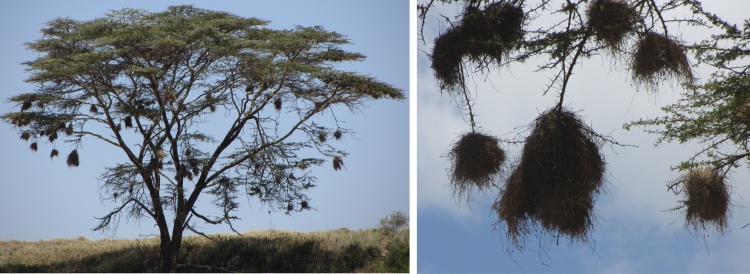
Speke's Weaver Bird Nests
|
Still having a long way to go, we soon sped off through open countryside where Maasai were patiently tending their herds of cattle and goats, usually by the roadside for some unknown reason. In the middle of nowhere, little old women could be seen painfully carrying heavy loads on their backs, others with bundles on their heads. Carts conveying all manner of goods were pulled by cows. Proud Maasai men stood by the wayside or sat grouped under trees in conference.
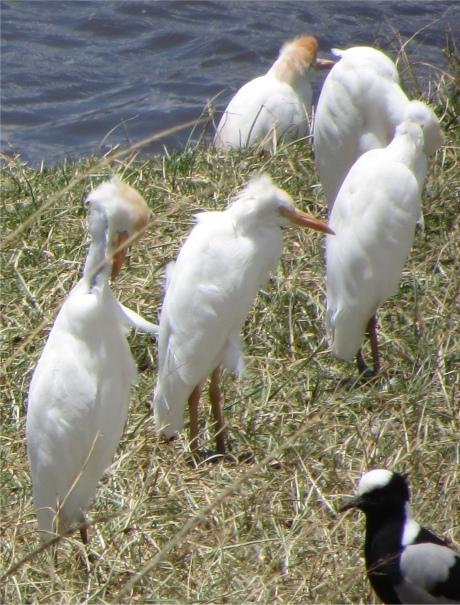
Lakeside Egrets
|
Villages and towns were passed, usually comprised of single story constructions of wood or brick, some brightly decorated in sponsors colours, all with dingy looking interiors, and in various stages of decay. The grocer next to a bar, then tyre centre, bar, butcher, metal supplier, garage, barber, cafe, timber store, snack bar, and on it went. There were always lots of people hanging around, standing or sitting in groups, dressed in clothes ranging from drab and dirty to bright and colourful, from traditional to European. Stalls selling fruit and vegetables, hot snacks, bricks, junk, donkeys, handcarts and motorbikes lined the dirt strips between the road and buildings. Habitations of any significant population always contained a collection of tuk tuks, which served as taxis.
A quick refuel at Mto Wa Mbu followed by a comfort stop, and we proceeded on to Arusha, a real bottleneck at the time of day we hit it. All the schools were teeming out hundreds of uniformed pupils, the streets were gridlocked, and horns were blasting. Despite having some higher storey buildings, the roadsides were still the same clutter of single storey shops and businesses. However, the atmosphere seemed much more affluent in this city compared to the villages we had just passed through. The cloud capped Mount Meru dominated the skyline of the city.

Blacksmith Plovers
|
Leaving Arusha far behind, the roadside soon became a blur of red soiled fields and colourful, noisy habitations. I was glad to see the looming mass of Kilimajaro appear, almost blending perfectly into the dull clouds cloaking it. It meant Moshi was not too far off.
Nelvin warmly greeted us at the Gladys Safaris office, but it was a bitter-sweet moment since we had to say farewell to Kepha and Erasto. They were a splendid team and had done their utmost to ensure our safari was a memorable experience. We had been expertly shown the wonders of this land, well informed, educated in Swahili, and eaten like kings. We hugged, shook hands and exchanged our thanks and farewells in Swahili; "Asante sana!", "Kwa heri!", "Tuonane baadaye!", etc. They have been great lads, full of fun and we had truly enjoyed their company. Gladys had done us proud with the pair.
Nelvin ushered us into the office where we filled our survey forms while he retrieved all the gear we had left behind in storage. He apologised because of the poor light in the office; there had been a power cut. After finalising with him transport arrangements to the airport for the following morning, we bade him farewell, and carried our individual worlds on our backs to the hotel next door.
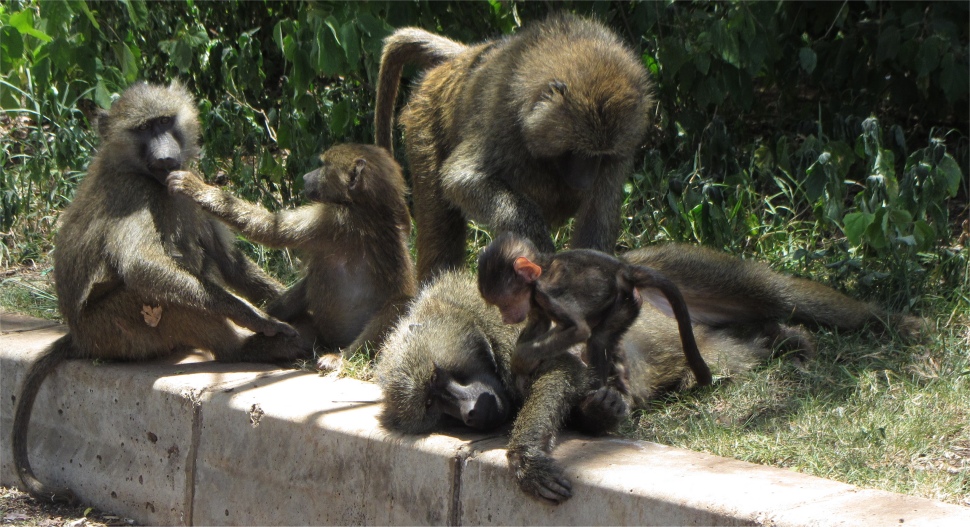
Baboons Grooming and Playing
|
It had been a long day, eleven hours spent driving, though the first five had been around the crater. All we wanted to do now was have showers and pack for the following morning - yet another early start. However, our hotel was struck by the same power cut, indeed the whole city was. Sally informed us that in the village where she used to live in Kenya, power cuts occurred often, and whenever there was a threat of lightening, the power would be cut manually, presumably to minimise potential damage caused by a lightening power surge along the lines. In Kisimu, where she now lived, power cuts did occur, though not as often as in the village. Outages could last from a few hours to well over a day.
We quickly rearranged our bags in the failing light, helped a little by the LED lamp brought in to us by the man on reception. By the time I got into the shower, it was dark. Tonight it was just a trickle, perhaps it was powered by a now non-functional pump. Accepting this was Africa, it was not the end of the world, and I emerged spick and span, ready for our evening meal together.
We accumulated in dribs and drabs, and set off to paint the town red, not so easy when it is rendered closed by the power outage. The only place in our vicinity that was open was easily located by the throb of generators. It called itself a delicatessen, but also served up Indian, Chinese, Italian, Japanese, Continental and other food, but sadly no alcoholic beverages. We ate our three course meal well, all for less than £3 per head; Sally said that was expensive for East Africa. Kepha's absence was noted, he had been good company during our meals on the safari.
Suitably sustained, we emerged into a world that was now lit up and full of noise again. The power had been restored. Poor Sally was all in, so Dan and I escorted her back to the hotel, before we found a place to enjoy a cool beer. We were enjoying savouring our beer, discussing the past few days, when all of a sudden three women at a nearby table shot up all at once in a startled manner, with much ruffling of feathers and verbal commotion. I guess a rat or snake had decided to join them. The three dears in their colourful dresses then settled down on a table next to us. Nice to know we were not perceived as a threat.
Having rounded off the day fully relaxed, we headed back to our hotel and settled down for the night. Dan was so whacked out he didn't even bother setting out his mosquito net. Bad move!

